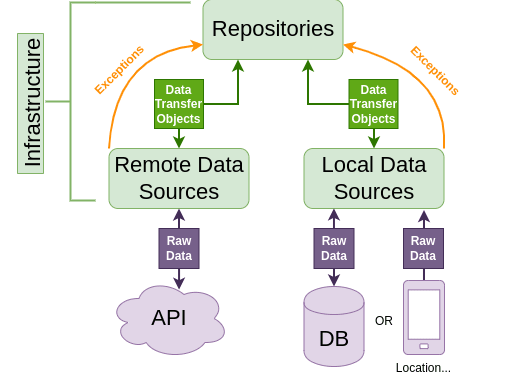Every application needs some data sources to receive the data and display it in the UI. So, it becomes very crucial how we, as developers, perform network requests. Handling API responses in an effective manner also determine the success or failure of our application.
In this post, we will see how to perform such network requests effectively using dio and a bit of functional programming using the dartz package. This will allow our overall architecture to remain consistent while making our project scalable and maintainable.
To follow along, make sure to include dio and dartz as your dependencies in the pubspec.yaml file.
Dio API Calls
First thing first, let’s take a look at how I used to make network requests in Flutter a while back 😂 when I was still a beginner.
class FeedRemoteDataSource {
FeedRemoteDataSource(Dio dio) : _dio = dio;
final Dio _dio;
Future<List<Feed>> fetchFeeds() async {
try {
final response = await _dio.get('some url path');
// Some other work
} on DioError {
// error handling
// return empty list.
}
}
}
This was how I did my network request returning a List of something no matter what. It worked fine for small projects; however, it didn’t take much longer for me to realize that I had been doing it wrong. As you can see in the code snippet above, I was always returning a List, irrespective of the status code.
In real-world projects, we are likely to work in a multi-layered architecture which means our entire project could be divided into multiple layers.
The layers can be:
Presentation Layer (consisting of UI code and ViewModel)
Domain Layer (consisting of entities and use-cases (optional))
Data Layer (consisting of DTOs, a repository, and data sources)
In this article, we will work closely with the Data Layer as it is what this article is about in the first place.
Now, getting back to the previous snippet. The fetchFeeds() method always returned a List. The presentation layer will then have no idea if the returned List was because of a successful request or unsuccessful. Because a successful request can also sometimes give an empty list if the database has no data. So, it was clear that I was doing it wrong ❌.
After spending some time looking at other people’s codes and tutorials 📖, I learned the importance of software architecture. 🤯
So, keeping proper architecture in our mind, let us redo the same request but in a proper way. 😎
Since I talked about architecture, let me begin with what our architecture for the data layer should look like.
Before we proceed any further, let me tell you that this is not the best architecture or the only architecture you can go with. Different people/teams have their own ideas regarding architecture and their own ways of doing things. However, every architecture makes sure to separate UI and business logic which is why software architectures exist.
Data Layer Architecture

So, our data layer would consist of three parts:
Data Transfer Objects (DTOs): They are the data layer representation of domain layer entities. They are also responsible for performing various data-related logic like conversion between Dart Object and JSON format and vice-versa. It also contains logic to convert domain layer entities into DTOs and vice-versa.
Data Sources: It is where we perform all of our network requests and the result is passed to the repository. All network-related exceptions that may arise are also thrown here which are then caught by the repository and converted to
Failure(about which we will see in a moment).Repository: The repository is what the view model communicates with. A repository also acts as a single gateway for data coming from several data sources. A repository is thus, essential in maintaining a single source of truth.
Data Transfer Objects (DTOs)
First, let’s see how our feed_dto.dart would look like.
part 'user_dto.freezed.dart';
part 'user_dto.g.dart';
@freezed // Import package freezed. [https://pub.dev/packages/freezed]
class FeedDTO with _$FeedDTO {
const factory FeedDTO({
required String title,
}) = _FeedDTO;
const FeedDTO._();
factory FeedDTO.fromJson(Map<String, dynamic> json) =>
_$FeedDTOFromJson(json);
factory FeedDTO.fromDomain(Feed feed) => FeedDTO(
title: feed.title,
);
Feed toDomain() => Feed(title: title);
}
You will also need to have freezed included in your project as a dev-dependency along with build_runner. Also, include freezed_annotation as a dependency.
freezed is a code generator for data-classes/unions/pattern-matching/cloning.
Next, you will need to have the required code generated which freezed and build_runner will take care of. Run the following command to initialize code generation.
flutter pub run build_runner watch --delete-conflicting-outputs
Data Sources
In this section, we will perform our network request using the dio package. Any exceptions that need to be thrown will be thrown in this section which then is handled by the Repository.
class FeedRemoteDataSource {
FeedRemoteDataSource(
Dio dio,
) : _dio = dio;
final Dio _dio;
Future<List<FeedDTO>> getFeeds() async {
try {
final response = await _dio.get<String>('some url path');
if (response.statusCode == 200) {
// decode json response
// return List<FeedDTO>
} else {
throw RestApiException(response.statusCode); // Custom class implementing Exception whose constructor accepts int
}
} on DioError catch (e) {
if (e.isNoConnectionError) {
// handle no connection error
} else if (e.response != null) {
throw RestApiException(e.response?.statusCode);
} else {
rethrow;
}
}
}
}
extension DioErrorX on DioError {
bool get isNoConnectionError =>
type == DioErrorType.other && error is SocketException; // import 'dart:io' for SocketException
}
Repository
This is the main gateway for the data coming from several data sources. Also, the ViewModel communicates with the Repository to get the data and display it in the UI. And the conversion between DTO and the domain-level entity is also performed here.
Now, how is our repository going to make it easy for us to handle exceptions so as to have a maintainable architecture? It’s simple. We use Either.
Eitheris an entity whose value can be of two different types, called left and right. By convention,Rightis for the success case andLeftis for the error one. It’s a common pattern in the functional community.
It might be difficult to get a grasp on Either just by looking at its definition. So, let’s take a look at our repository implementation which will help us understand Either easily.
The FeedRepositoryImpl class implements FeedRepository which is a simple abstract class. The FeedRepositoryImpl is dependent on our FetchRemoteDataSource.
abstract class FeedRepository {
Future<Either<Failure, List<Feed>>> getFeeds();
}
class FeedRepositoryImpl implements FeedRepository {
FeedRepositoryImpl({
required this.remoteDataSource,
});
final FeedRemoteDataSource remoteDataSource;
@override
Future<Either<Failure, List<Feed>>> getFeeds() async {
try {
final result = await remoteDataSource.getFeeds();
return right(result.toDomainList);
} on RestApiException {
return left(
const Failure.serverError(),
);
}
}
}
extension DTOListToDomainList on List<FeedDTO> {
List<Feed> get toDomainList => map((e) => e.toDomain()).toList();
}
Now, now, now!! What is that method returning Future<Either<Failure, List<Feed>>> ??? 🤯😵💫 And how can a method return two different data types? 😵💫
If you are thinking the same, then it’s just as simple as it can get.
Either<A, B> means that a method will return either A or B depending on the situation. It won’t return both A and B.
In our case, the getFeeds() returns Future<Either<Failure, List<Feed>>> meaning either Failure or List<Feed> . And because we are dealing with asynchronous code, we also have Future.
Failure is just a simple union class that is created using freezed package.
part 'failure.freezed.dart';
@freezed
class Failure with _$Failure {
const factory Failure.serverError() = _ServerError;
const factory Failure.anotherFailure() = _AnotherFailure;
}
If you had run the build_runner watch command earlier, saving the above failure.dart file will automatically generate a bunch of code for you. Else run the command again.
flutter pub run build_runner watch --delete-conflicting-outputs
So, our repository implementation is pretty straightforward now. If the remote data source returns relevant data, then the repository will return Right i.e. List<Feed> else it returns Left i.e. Failure. Notice how the exceptions that were wildly being thrown from the remote data source are now gone because the repository implementation returns the Dart object. 🤩
This way, we also reduce the risk of the error bubble.
BLoC / ViewModel
So, how exactly are we going to deal with the obtained result from the repository in the presentation layer? For that, we will need to create a bloc that will be dependent on the repository. I prefer using flutter_bloc for state management purposes.
You needn’t use flutter_bloc to follow along. Any state management solutions are fine. 👍️
part of 'timeline_bloc.dart';
@freezed
class TimelineEvent with _$TimelineEvent {
const factory TimelineEvent.feedFetched() = _FeedFetched;
// add some other events too as desired...
}
part of 'timeline_bloc.dart';
@freezed
class TimelineState with _$TimelineState {
const factory TimelineState.loading() = _Loading;
const factory TimelineState.loaded({required List<Feed> feeds}) = _Loaded;
const factory TimelineState.failed() = _Failed;
}
class TimelineBloc extends Bloc<TimelineEvent, TimelineState> {
TimelineBloc(
FeedRepository repository,
) : _repository = repository,
super(const TimelineState.loading()) {
on<TimelineEvent>(
(event, emit) async {
await event.when<Future<void>>(
feedFetched: () => _onFeedFetched(emit),
);
},
);
}
final FeedRepository _repository;
Future<void> _onFeedFetched(Emitter<TimelineState> emit) async {
final fetchedFeed = await _repository.getFeeds();
fetchedFeed.fold<void>( // fetchedFeed is a Either type. We use fold to say what to do for each case i.e. for `Failure` and `Success` cases.
(failure) => emit(const TimelineState.failed()),
(feeds) => emit(TimelineState.loaded(feeds: feeds)),
);
}
}
In the _onFeedFetched() method above, the instance of the class implementing FeedRepository (the abstract class) is used to call the getFeeds() method which returns an Either type (stored in fetchedFeed). We use fold method to emit proper state depending on the result of _repository.getFeeds().
The fold accepts to functions as its argument. The first function is used to perform an action when Failure is returned, whereas the second function is used to perform an action when a Success is returned. Success in our case refers to List<Feed>.
Now, from our UI, we can use BlocBuilder to rebuild our widget on certain state changes.
Other Solutions
There are many other ways to effectively handle exceptions in our Flutter project. We can also rely on sealed classes. A good example of it can be found here.
Conclusion
In this article, you saw how to implement network requests in Flutter in a proper manner. We learned how we can use dio, freezed, dartz, and a few other architectural overviews that can help us in making our app more maintainable, and testable and ultimately help us in becoming a better developer.
Also, this was my very first blog on Dev. I know there is room for improvement and therefore, I seek feedback from the community.
If you wish to read this article in Bahasa Indonesia, you can find it here. Yunus Afghoni has done good work taking this article as a reference and translating it to Bahasa Indonesia, with some subtle changes.
If you wish to see some Flutter projects with proper architecture, follow me on GitHub. I am also active on Twitter @b_plab.
My Socials
Until next time, happy coding!!! 👨💻
— Biplab Dutta






Latest comments (2)
Great article, Biplab
Thank you Obinna for appreciating my work. I will be uploading a new article every weekend. So, keep checking them out. ✌️